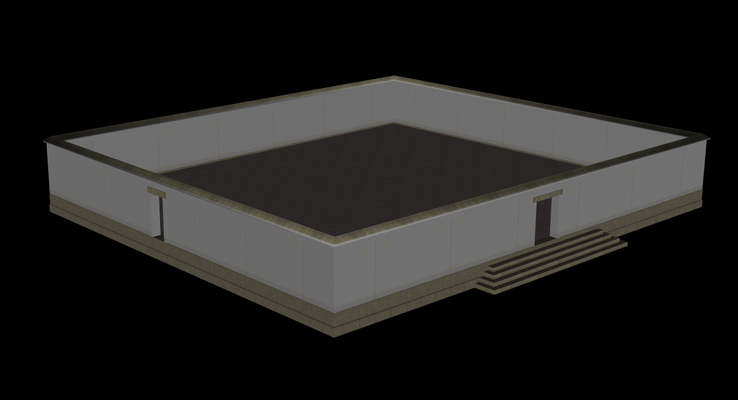|
|


A series of serious issues arise for the digital reconstruction of this building. We have its surrounding wall, but nothing survives within it. The form of the interior depends on the use of the building. There are roughly two hypotheses: according the first view, this building is identified as the Heliaia, the law court of Athens, which means that we should represent a roofed building, as featured in the Ancient Agora scale model [see Thompson, H.A. – Wycherley, R., The Agora of Athens. The American Excavations in the Athenian Agora, vol. XIV, American School of Classical Studies at Athens (Princeton 1972), pp. 62-65]. The latest theories identify this building as the Aiakeion [Stroud, R., The Athenian Grain-Tax Law of 374/373 B.C. ( Hesperia Supplement 29, Princeton 1998), pp. 85-108] representing an enormous enclosure (peribolos) of 821 m 2, surrounding a grove [Mc Camp II, J., ‘Rectangular Peribolos’, in Boegehold, A., (ed.) The Law Courts of Athens. Literary and Epigraphic Testimonia, The American Excavations in the Athenian Agora, vol. XXVIII, American School of Classical Studies at Athens (Princeton 1996), pp. 99-103]. We have adopted the second view and followed the drawings of the former architect of the Agora W.B. Jr. Dinsmoor, as these were implemented in the Agora maquettes for Athens of the Classical period [e.g. Lang, M., The Athenian Citizen. Democracy in the Athenian Agora, revised edition by Mc Camp, J. II (Princeton 2004), plate 2]. This building was erected in the late 6th cent. BC. Although only one slab of its superstructure survives in its original place, the peribolos is accurately represented, since the coping of the wall’s upper part has been unearthed in a nearby spot. The digital reconstruction is speculative only with respect to the height of the peribolos, based on the reasonable assumption that it must have stood taller than a person of ordinary height. Two phases are represented: one for the Classical period, with an entrance in its east side accessed via a five step stairway, dated to c.480 BC, and one for the Hellenistic period, when the building acquires its final form. We have also constructed a version for the 4th cent. BC, comprising a series of rooms in its south side, to allow for a fuller understanding of the structure. We have also accepted Mc Camp’s hypothesis suggesting the existence of a propylon in its enlarged north entrance.

Aiakeion, 3D Representasion, Classical period
|
|

